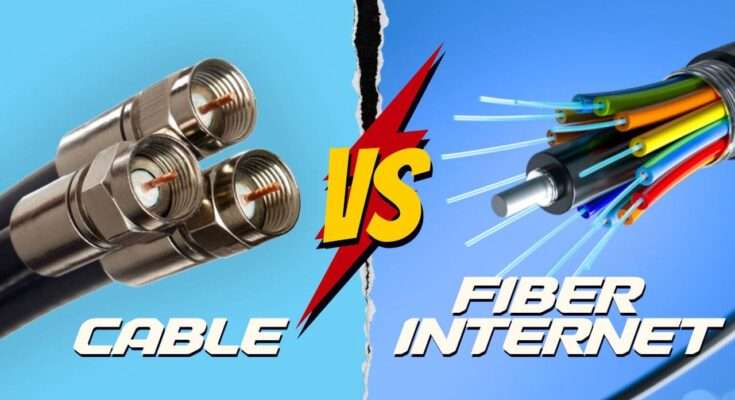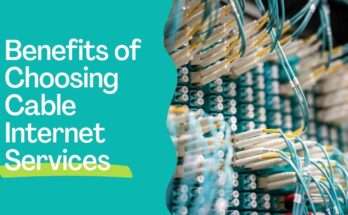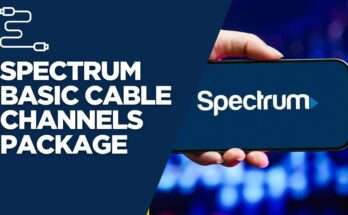When any member of your family is bulling for quicker gaming with fiber-optic Internet. Sometimes, your own Internet service chokes and lags when you wish to deliver large files or broadcast the U.S. Open for supporters. There may be also a situation when your contender is a step ahead in offering quick Internet service with the recent digital deals to attract their consumers.
There may be possibilities that you depend on these Internet services for your regular operations. You always try to remain at the top of these contenders to obtain new technologies that assist you in developing your business. So, fiber Internet can be best in this direction.
But you need to know how better is Internet cable vs fiber. In this write-up, we will be providing the complete details and comparison between cable vs fiber Internet.
What is a Cable Internet?
Cable Internet plans utilize cable TV lines i.e. coaxial cables entering your office or home to attach you to the Internet. This provides quick download speed, excellent efficiency and broad presence which you can obtain where you reside.
Coaxial cables include a copper (copper-clad steel) core, aluminum, copper shields, an outer plastic layer and an insulating sheath. The copper core wire supplies data waves that are customized radio waves transmitted via unused cable TV channels. The method by which cable Internet providers position these coaxial cables means that connections from each home move to your neighborhood via the entrance or nearby location. Your provider’s fiber network takes from the location where you are supposed to live and where the cable Internet provider comes to set up the fiber. It can be the major difference between fiber vs cable Internet.
Top Cable Internet Plans
| Package | Speed | Cost |
|---|---|---|
| Spectrum Internet Premier | Up to 500 Mbps | $60 per month |
| Xfinity Gigabit Extra | 1300 Mbps | Xfinity for Cost |
| Cox Go Even Faster | 500 Mbps | $90 per month |
| Optimum 1 Gig Internet | 940 Mbps | $70 per month |
If you don’t require the additional upload speed of the fiber Internet, the cable is still an excellent method to move. It’s more broadly present, utilized by establishing cable TV lines and often affordable compared to fiber. This can be the best option for fiber-optic Internet vs cable.
Comparing Cable Internet Provider Plans and Pricing
| Internet Provider | Speed | Cost | Consumer Rating |
|---|---|---|---|
| Xfinity | Beginning at 150 Mbps | Beginning at $35 per month | 3.9 |
| Spectrum | Up to 50 to 1000 Mbps | $25 to $70 per month | 3.7 |
| Cox | Up to 100 to 2000 Mbps | $50 to $150 per month | 3.7 |
| Optimum | 300 to 8000 Mbps | $40 to $280 per month | 3.3 |
| WOW | 100 to 1200 Mbps | $19.99 to $94.99 per month | 3.6 |
| Astound Broadband | Up to 300 to 1500 Mbps | $20 to $70 per month | 3.6 |
What is Fiber Internet?
Fiber Internet utilizes fiber-optic lines racing your office or house to attach you to the Internet. Fiber Internet plans provide superfast upload and download speeds but you will be fortunate if it is present in your region.
Fiber utilizes laser pulses or LED to demonstrate ones and zeroes which are the basic unit of data. The signals are obtained by equipment on your end and explained as information but with light instead of sound.
A single fiber cable usually has 1 optical constructed of plastic or fiber. Yellow single cables have a thin core between 8 to 10 µm featured to deliver a measured beam traveling long distances up to 25 miles. Aqua Multimode and Orange cables have a bigger core of up to 50 to 100 µm featured to emerge different beams around short distances up to 1000 feet which is excellent for information centers. It can also affect the major part while comparing between fiber Internet vs cable.
Top Fiber Internet Packages
| Package | Cost | Speed |
|---|---|---|
| T-Mobile Fiber 1 Gig | $75 per month | 1000 Mbps |
| AT&T Internet 1 Gig | $80 per month | 1000 Mbps |
| Google Fiber Home 3 Gig | $100 per month | 3000 Mbps |
| CenturyLink Simply Unlimited Fiber Internet up to 5000 Mbps | $50 per month | 500 Mbps |
| Verizon Fios 500 Mbps | $74.99 per month | 500 Mbps |
| Frontier Fiber 1 Gig | $64.99 per month | Up to 1000 Mbps |
| Optimum 1 Gig Fiber Internet | $70 per month | 940 Mbps |
Fiber Home Internet presence is restricted around the United States. If you have activation to fiber Internet in your region, it’s a good option over cable because it provides equivalent quick upload and download. It’s more efficient and utilizes unenergized equipment between you and the fiber provider. The supply isn’t impacted by external intervention such as cable Internet.
Comparing Fiber Internet Provider Plans and Pricing
| Internet Provider | Speed | Cost | Consumer Rating |
|---|---|---|---|
| Google Fiber | 1000 to 8000 Mbps | $70 to $150 per month | 4.3 |
| T-Mobile 5G Home Internet | 300 to 2000 Mbps | $40 to $110 per month | 4.1 |
| AT&T Fiber | 300 to 5000 Mbps | $55 to $250 per month | 3.9 |
| Verizon | 300 to 2300 Mbps | $49.99 to $109 per month | 3.9 |
| CenturyLink | 500 to 940 Mbps | $50 to $75 per month | 3.6 |
| Frontier | 200 to 7000 Mbps | $29.99 to $199.99 per month | 3.5 |
| Optimum | 300 to 8000 Mbps | $40 to $280 per month | 3.3 |
Comparing Cable vs Fiber
In Terms of Speed, Cost, Device Setup and Availability
Speed
- Cable Internet – This Internet provider delivers 20 to 2000 Mbps download speed and 5 to 200 Mbps upload speed. Latency is bigger almost 100 ms and can impact tasks such as video conferencing or gaming.
- Fiber Internet – This Internet provider offers consistent download and upload speeds between 250 to 50,000 Mbps. This has a much lower latency almost 17 ms which makes it perfect for huge bandwidth tasks such as gaming, streaming and distant work online.
Equipment and Device Setup
- Cable Internet – This Internet provider utilizes coaxial cables like copper wires for data supply. Establishment is convenient and often involves self-establishment kits. If a cable TV structure is established, the establishment is user-friendly and fast.
- Fiber Internet – This Internet provider depends on fiber cables constructed of glass strands that supply information as light signals. The establishment is more difficult and usually needs professional technicians to deploy committed fiber lines to the house. A few Internet providers may cost for setup unless a fiber term is already in position.
Availability
- Cable Internet – This cable Internet is broadly present because of the established cable TV structure with an extent approaching almost 82% of the United States. It’s more acceptable in urban and suburban regions.
- Fiber Internet – Low extensive including around 42% of the United States families. Presence exists in urban regions, despite the extent is going on. Less widespread, covering about 43% of U.S. households.
Cost
| Package | Cost Beginning At | Type |
|---|---|---|
| AT&T Internet 1 Gig | $80 per month | Fiber |
| Google Fiber Core 1 Gig | $70 per month | Fiber |
| Frontier Fiber 1 Gig | $64.99 per month | Fiber |
| Verizon Fios 1 Gig | $89.99 per month | Fiber |
| Cox Go Super Fast | $110 per month | Cable |
| Optimum 1 Gig Internet | $70 per month | Cable and Fiber |
| Spectrum Internet Gig | $70 per month | Cable and Fiber |
| Xfinity Gigabit Extra | Examine Xfinity for Cost | Cable |
| Wow Fiber 1 Gig | $80 per month | Fiber |
Conclusion
Fiber Internet plans offer premier efficiency and speed that makes it a superb option for desired activities such as gaming or distant work if present in your region. Cable Internet remains an experimental alternative because of its wider presence and cost-effectiveness. Fiber is perfect for common family and business usage. Cable Internet provides excellent worth. To know more about Internet plans, get in touch with Internet Cost Saver customer care number – +1(855)-208-9742.



